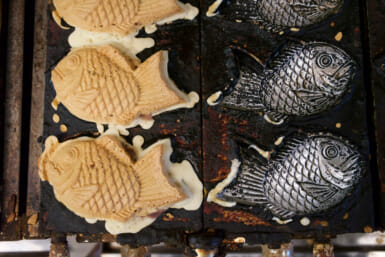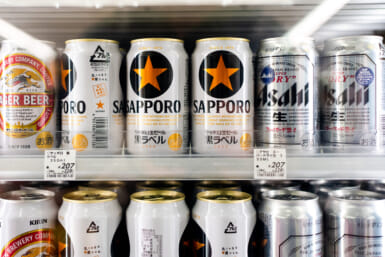with Elizabeth Andoh
The chilly weather brings an abundance of fruits and vegetables dear to every Japanese.
Among them are the highly prized matsutake mushrooms which will dispell any notions that “eating like the natives” is synonomous with “cheap.”
I debated devoting this column to that fabulous fungi but then realized that few, if any, of you would spend the ¥1,000 or so necessary to purchase a single mushroom. Suffice it to say that thinly sliced they add a marvelous touch to suki-yaki.
So on to the practical.
Chilly weather also means soup weather, and the national brew is miso shiru. There must be hundreds of variations on the general theme, but for starters here are three simple to prepare, inexpensive yet hearty examples:
MISO SHIRU I (tofu and okra, with Sendai miso)
ingredients:
- 4-5 cups flavored dashi
- Sendai miso; approximately 3/4 tablespoon for every cup of dashi
- 1 cake of tofu
- 6-7 fresh okra
instructions:
1. Heat thru the dashi and dissolve the miso paste in it. Stir well.
2. Add drained tofu that has been cut into small (about 1/2 inch) cubes. Continue to heat the soup for 2-3 minutes, but do not allow it to come to a boil.
3. Rub fresh okra with coarse salt (this is a fine way to “wash” the vegetable) and quickly blanch them in rapidly boiling water until bright green and barely tender. Drain the okra and cut in 1/4 inch thick slices (they will be star-shaped) discarding the tips and stems.
4. Add the cut okra to the soup and remove from heat. Serve hot. Figure approximately 3/4 cup per serving.
notes:
1. Sendai miso is dark in color and pungent in flavor. Available in any Japanese market for about ¥140 for 500 grams. Check the label with someone who can read Japanese. (This is the same miso that was used in the Aug. 23 recipe for miso-an-kake).
2. Tofu is available everywhere. Drain off any excess liquid from the pack. For even more efficient draining, wrap the tofu in cheesecloth and gently weight it down (use a plate or two) for an hour or so before using.
3. Okra is called “okura” in Japanese. An originally Western vegetable very much favored by the natives and used extensively in “Japanese” cooking.
MISO SHIRU II (shiitake and mitsuba, with Sendai miso)
ingredients:
- 4-5 cups flavored dashi
- Sendai miso; approximately 3/4 tablespoon for every cup of dashi
- 5-6 fresh shiitake
- 1 small bunch mitsuba
instructions:
1. Heat thru the dashi.
2. Slice the fresh shiitake into thin inch thick) slices and add them to the dashi. Simmer for 2-3 minutes.
3. With a ladle, remove about 1/2 cup of dashi from the pot, to a bowl. Dissolve the miso paste in this dashi and then return it to the larger pot. Stir well.
4. Rinse and pat dry a small bunch of mitsuba, cutting it into 1 inch lengths (discard the bottom section of the stems).
5. Add the mitsuba to the soup, remove from the heat and serve hot. Figure approximately 3/4 cup per serving.
notes:
1. Shiitake are black mushrooms, available fresh during the cold months. Wipe them with a damp cloth, remove and discard stems before slicing.
2. Mitsuba are three-leafed (that’s what the name means) plants on long, slender stalks. Similar to watercress or parsely in use as a garnish, but refreshingly different in taste.
MISO SHIRU III (turnips and scallions, with Shinshu-ichi miso)
ingredients:
- 4-5 cups flavored dashi
- Shinshu-ichi mlso; approximately 3/4 tablespoon for every cup of dashi
- 1 bunch fresh turnips (approximately 1 large turnip per serving)
- 1-2 stalks wakanegi or asatsuki
instructions:
1. Heat thru flavored dashi.
2. Wash turnips, peel them and cut off roots. Slice large turnips into 6 wedges (smaller turnips in half or quarters) and add them to the warm dashi. Simmer for 4-5 minutes or until soft when speared with a tooth-pick.
3. With a ladle, remove about 1/2 cup of dashi from the pot, to a bowl. Dissolve Shinshu-ichi miso paste in this dashi and return the dissolved mixture to the larger pot. Stir well.
4. Wash and pat dry several stalks of wakanegi or asatsuki. Use the green part only, chopping it into small pieces.
5. Add the wakanegi or asatsuki to the soup. Stir and remove from the heat. Serve hot and figure on about 94 cup per serving.
notes:
1. Shinshu-ichi miso is dark beige in color and mellower in flavor than Sendai miso. Available in any Japanese market; check the label with someone who can read Japanese.
2. Turnips are called kabu in Japanese (the smaller ones may be called ko-kabu). If the leaves are fresh, these may be washed, patted dry and cut into 1-inch lengths to be added to the soup between stages 2 and 3 of the instructions. Or they may be treated as any other leafy green and prepared like Komatsu No Goma Ae.
3. Wakanegi are those thin, long leeks, 4/5 of which are green (unlike regular naganegi which are thicker and predominantly white). Asatsuki are those delicate looking scallions with small white bulbs. Either vegetable is available during the fall in any Japanese market.








